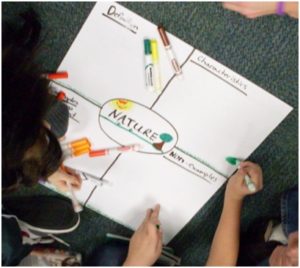Teachers love getting new strategies and when I provide teacher professional development I like to please my customers, but I am disappointed when I overhear teachers planning to immediately use a strategy I have provided and there is no mention of how it will enhance student learning of their content. I have also observed teachers compliantly using strategies provided as part of a school wide initiative with no regard to how it can impact learning. Many times teachers want to be able to say that they have tried the strategy or to check it off their list.
I want to see teachers learning the strategies provided, determining which strategies fit the needs of the students and enhance the lesson being taught. When the teacher modifies the strategy I know they have a deeper understanding of how it can best be used in their classroom.
The following is an example of a teacher doing just that – taking some risks, using strategies learned in his schools required professional development, and successfully helping students learn by reviewing important content.
Marc is a twelve year veteran high school teacher. He has taught freshman Integrated Science for the past five years and has three classes this year. His school is in its second year of participation in a school wide literacy model. He has successfully used several strategies, the anticipation guide, the Frayer model and a limited word wall. He has heard his colleagues discuss their use of the academic dialogue strategies provided as part of the literacy initiative with excitement and he wants to join them in this discovery but is hesitate because he feels his students are easily distracted, he doesn’t have tables, only desks and he feels that moving the room around will take up too much class time. At the suggestion of his literacy coach Marc observed a colleague with a similar classroom setup move students in and out of activities successfully and then he was ready to try on his own. Students were finishing a unit and this was a great time to review and prepare for the final exam. Marc selected the essential vocabulary that the students would need to know to do well on the exam. His list consisted of twelve words/concepts. Since Marc had successfully used the Frayer model before but not with this unit he decided to use this strategy for review. The lesson was put in motion using parts of the café conversation strategy learned in a recent professional development.
During the lesson Marc moved around the room guiding the students to the level of understanding needed and responding to questions. He prepared the chart paper before class and started the class with an explanation that moving quickly was essential to completing the process. He would be timing the movement with a wonderfully loud chicken timer. The timer was demonstrated once and students were shown an example of how to arrange the desks into groups of four. Students were asked to select one person to come to the front and receive their beginning word. They were given two minutes to complete the task of moving the furniture and being ready to start work on their task.
An accountability method was needed, therefore, each group was given one post-it note and the group selected the person responsible for keeping track of the note. As students worked Marc gave tallies on the post-it note to groups based on his observations. Groups working together cooperatively, all group members on task and asking questions of each other were awarded points and told why they were receiving the tally. Examples: I like the way each of you has taken turns writing on the chart. You are asking good questions and everyone is trying to respond appropriately. No one is off task gazing out the window, very good.
Students were given 5 minutes to brainstorm the responses for the second quadrant. Students worked diligently. The noise in the room was higher than normal but all students were on task and Marc was very pleased with what he was observing. Students then rotated to the next station and spent 5 minutes responding to the third quadrant, then the fourth, and finally the first.
The charts were placed around the room and Marc debriefed the responses.
Marc had not thought the timer would work and he was surprised at how fast the students moved into position and went straight to work without wasting any time. He was, also, very pleased with the responses the students gave. They were of much higher quality than what he had received in the past.
Marc took two strategies and combined them. He was comfortable with the Frayer model and used it as his discussion points for the café conversation. His modifications met the needs of the students and he didn’t overwhelm himself by trying to come up with good questions for the café conversation but used something he and his students had done before. This is what I want to see. It isn’t rocket science just great teaching.


